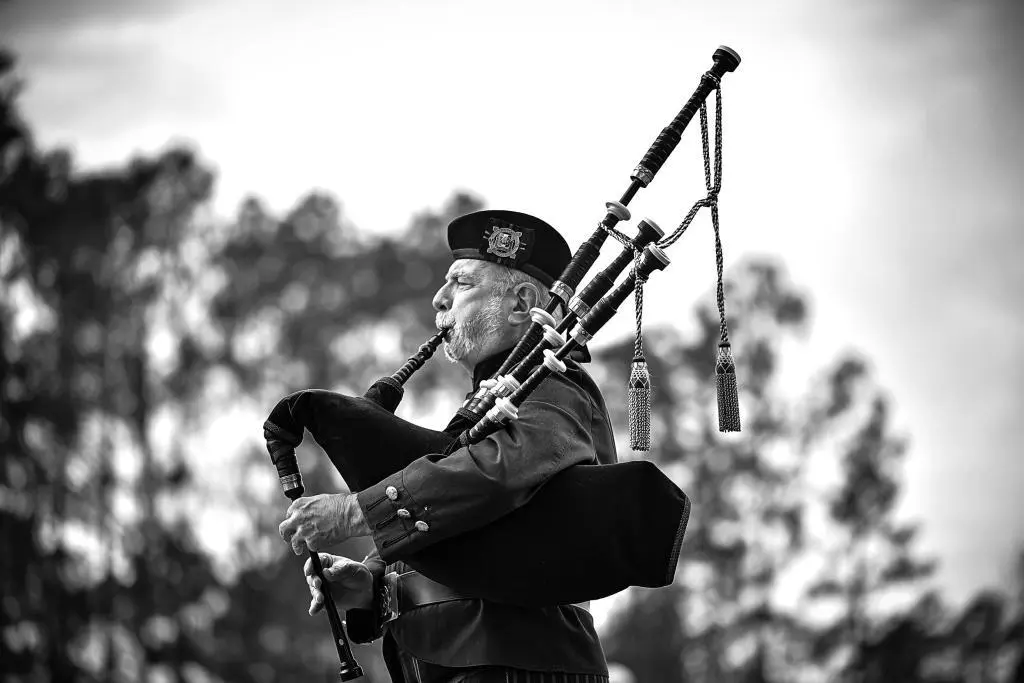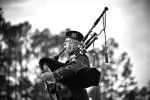Embellishments in music, and specifically in the context of the Scottish Highland Bagpipes, are ornamental notes, graces, or short musical passages which are used to enhance the melody.
They add complexity, stylistic nuance, and character to the music. Embellishments can be characterized as any combination of notes and gracenotes (quick, auxiliary notes) that vary from the principal or sustained pitch.

What is Embellishment: Table of Contents
Deep within the heart of Scottish cultural tradition resonates the evocative and distinctive sound of the Highland bagpipes. More than an instrument, the bagpipes stand as a symbol of Scottish pride and heritage, echoing through the highlands and valleys, telling tales of history, bravery, and an enduring love for music.
Bagpipe music is unique, not just for its robust and intense tonal quality, but also for its distinctive musical structure. Its characteristic sound stems from a combination of elements, chief among them being melody notes and drone tones. Yet, to truly understand and appreciate this music’s essence, one must delve into the subtle nuances that bring it to life – and here’s where we introduce the concept of ’embellishment’.
Embellishments in the realm of Scottish Highland bagpipe music are akin to intricate motifs woven into a rich tapestry. They’re not merely decorative elements but integral threads that add depth, complexity, and individuality to the overall musical pattern. In bagpipe music, embellishments generally refer to any combination of notes and gracenotes played other than a sustained pitch. They add rhythmical agility and melodic ornamentation, creating a unique aural experience that defines the bagpipe sound.
Defining Embellishment in the Context of Bagpipe Music
In the realm of Scottish Highland bagpipe music, the term ’embellishment’ carries a profound meaning, embodying a complex interplay of rhythm, melody, and emotion. For bagpipe players, understanding and mastering embellishments is akin to learning a unique language, one spoken through the fingers and voiced through the pipes.
An embellishment in bagpipe music can be thought of as a micro-composition within the larger composition. It’s a complex note sequence, consisting of one or more gracenotes (rapid, auxiliary notes) and melody notes, played in quick succession. Each embellishment offers a burst of musical information that enhances the melody’s continuity and rhythm.
What sets embellishments apart is that they are not sustained pitches. Instead, they represent quick, articulated notes that provide contrast and relief to the longer, sustained notes of the melody. This unique blend of long and short, sustained and rapid, forms a dynamic interplay that makes bagpipe music so compelling.
The role of embellishments in a bagpipe piece is manifold. Not only do they add rhythmic variety and melodic complexity, but they also serve a functional role in transitioning between notes. Embellishments allow pipers to move from one note to another, even a note of the same pitch, without breaking the flow of sound. This creates a seamless, continuous sound that is characteristic of bagpipe music.
But the role of embellishments extends beyond the technical to the emotional. They infuse the music with expression and vitality, conveying feelings that words cannot. A well-placed embellishment can evoke a sense of anticipation, excitement, sadness, or joy, adding an emotional layer to the music.
Fundamentals of Embellishments in Bagpipe Music
A fundamental understanding of embellishments requires a deep dive into the unique components that construct them – the melody notes and gracenotes. The beauty of bagpipe music lies in the balance and interplay between these two elements.
Melody notes are the foundational blocks of any piece of music. They create the main body of the tune, providing the basic framework upon which everything else is built. In the context of bagpipe music, these notes are sustained, forming the key thematic elements of the composition.
Gracenotes, on the other hand, are like lightning flashes against a dark sky. They are short, auxiliary notes that aren’t meant to stand on their own. Instead, they interact with the melody notes, creating rhythmic and melodic variations that add depth and complexity.
Embellishments in bagpipe music are carefully crafted sequences of gracenotes and melody notes. The gracenotes are played extremely quickly, almost merging with the melody notes, yet they maintain their distinct character. This rapid shift between gracenotes and melody notes is what gives bagpipe music its unique rhythmic agility.
The impact of embellishments on the overall melody and rhythm of a piece is substantial. By creating mini rhythmic patterns within the larger melody, embellishments add a layer of rhythmic complexity. They provide a sense of momentum and flow, driving the music forward.
Embellishments also add melodic interest. By introducing brief variations to the melody, they break up potential monotony, making the music more engaging and dynamic. The quick gracenotes also create a sense of tension and release, contributing to the emotional expressiveness of the music.
However, embellishments are not just about adding more notes. They’re about understanding the music’s flow and knowing when to introduce variation. Each embellishment must be strategically placed and executed with precision to enhance the music without overwhelming it.
Exploring Different Types of Embellishments: Taorluath and Hornpipe
When it comes to bagpipe music, embellishments are as diverse as they are crucial. Among the myriad embellishments that exist, two stand out for their intricate construction and potent musical impact: Taorluath and Hornpipe.
Taorluath is a complex embellishment that consists of a unique sequence of gracenotes and melody notes. Its name is Gaelic in origin, meaning “full of sound,” an apt description for the musical richness this embellishment brings. It starts with a melody note, followed by a rapid succession of gracenotes, and ends with another melody note. Often used in Piobaireachd (classical bagpipe music), the Taorluath provides a rhythmic flourish that adds a sense of urgency and excitement to the melody.
Understanding and playing a Taorluath requires skill and precision. The gracenotes must be executed swiftly and accurately, with seamless transitions to the melody notes. Despite its complexity, a well-played Taorluath feels smooth and flowing, like a swift musical ripple that enhances the melody without disrupting its continuity.
Hornpipe, on the other hand, isn’t a specific embellishment but rather a type of tune, characterized by unique rhythmic patterns and frequent use of certain embellishments. Hornpipes are traditionally associated with lively, upbeat music, often played for dances. The embellishments used in hornpipes, such as shakes (a quick alternation between two notes) and doublings (quick repetition of a note separated by a gracenote), add to the music’s rhythmic vitality and drive.
A hornpipe’s melody is generally quite catchy, but it’s the use of embellishments that makes it truly shine. The embellishments contribute to the tune’s energetic character, creating dynamic rhythmic variations that make your foot tap and your heart dance.
Both Taorluath and hornpipe represent the incredible versatility and musical impact of embellishments in bagpipe music. They demonstrate how strategic use of gracenotes can transform a simple melody into something vibrant, engaging, and deeply moving. Whether it’s the rhythmic ripple of a Taorluath or the lively dance of a hornpipe, these embellishments contribute significantly to the unique sound and emotional expressiveness of Scottish Highland bagpipe music.
Role of Embellishments in Bagpipe Performance and Composition
In the panorama of Scottish Highland bagpipe music, embellishments serve both a technical and expressive function. They are integral to performance and composition, requiring a deep understanding of the music and a high level of technical skill to execute effectively.
From a compositional standpoint, embellishments serve as an essential tool for creating rhythmic and melodic variations. They are used strategically to enhance the melody, provide transitions between notes, and introduce moments of tension and release. In essence, embellishments are like spices in a dish – added judiciously, they can transform a simple tune into a rich and flavorful musical piece.
The practical role of embellishments extends to performance as well. A well-executed embellishment can accentuate a specific note, underscore a rhythmical pattern, or inject a burst of energy into the performance. Embellishments also aid in maintaining the continuous flow of sound that is characteristic of bagpipe music, allowing pipers to move between notes of the same or different pitches seamlessly.
The performer’s role in effectively using embellishments cannot be overstated. Each embellishment must be executed with precision and musical sensitivity, considering its impact on the overall melody and rhythm. The performer must also understand the emotional context of the piece, as the expressive power of embellishments can significantly contribute to conveying the intended emotion.
Moreover, the performer needs to maintain a delicate balance. While embellishments add interest and complexity, overuse or misuse can lead to a cluttered and confusing sound. It’s like walking a tightrope – too few embellishments and the music may seem plain and monotonous; too many, and the core melody can be obscured.
Understanding and mastering embellishments thus requires more than technical skill. It demands a keen musical sense, an intuitive understanding of the music’s flow, and the ability to communicate emotion through the instrument. It’s a dance between the fingers and the heart, between sound and silence, between tradition and innovation – a dance that brings Scottish Highland bagpipe music to life.
Case Study Analysis
To fully grasp the value and impact of embellishments in Scottish Highland bagpipe music, we’ll now take a closer look at a few selected pieces. Both traditional and contemporary works will be examined to appreciate the diverse ways embellishments are incorporated and how they contribute to each piece’s overall appeal.
- Traditional Bagpipe Piece: “The Battle of Waterloo”
“The Battle of Waterloo,” a traditional Scottish bagpipe tune, exemplifies the strategic use of embellishments. It’s a lively march, where embellishments like doublings, strikes, and grips are used to emphasize key notes and drive the rhythm. The Taorluath embellishments, in particular, add a compelling rhythmic energy to the piece. They provide rhythmic variety, enhance the melody, and infuse the music with a spirited, marching character that aligns perfectly with the theme of the tune.
- Contemporary Bagpipe Piece: “Caledonia” by Dougie MacLean (Bagpipe Cover)
This contemporary cover of Dougie MacLean’s “Caledonia” showcases how embellishments can be adapted to modern music styles. The performer skillfully uses embellishments to add rhythmic interest and melodic complexity. For instance, you can hear careful use of doublings and Taorluaths to decorate the melody. Despite being a slower, more emotive piece than “The Battle of Waterloo,” the embellishments ensure that the music retains a dynamic and engaging character.
- Piobaireachd: “Lament for the Old Sword”
Piobaireachd, or “pibroch,” represents the classical music of the Highland bagpipe. “Lament for the Old Sword” is an excellent example where embellishments play a crucial role. In this form of music, the melody is slow and sustained, with embellishments like Taorluath and Crunluath providing rhythmic variation and emotional depth. They punctuate the melody, creating peaks and valleys of tension and release that give the lament its deeply evocative character.
In each of these pieces, the embellishments serve a critical function. They enhance the melody, drive the rhythm, and express the music’s emotional essence. They highlight the performer’s technical skill and musical sensitivity, adding a layer of complexity and depth that makes the music engaging and moving. These case studies demonstrate that regardless of the musical style or period, embellishments remain a defining feature of Scottish Highland bagpipe music.

